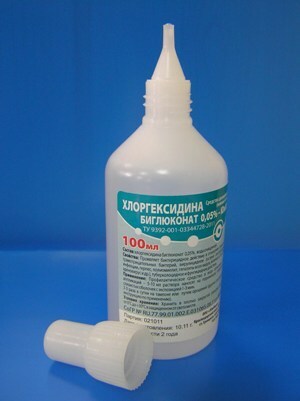 Chlorhexidine refers to drugs that have antiseptic and antibacterial properties. It is widely used in medical institutions for disinfection of various instruments.
Chlorhexidine refers to drugs that have antiseptic and antibacterial properties. It is widely used in medical institutions for disinfection of various instruments.
Its popularity is due not only to the ability to effectively kill bacteria, but also the ability to maintain its properties for a long time after use.
Chlorhexidine is produced in various forms: tablets, solution, gel, aerosol. But to rinse your mouth, it's liquid that is used( 0.05% aqueous solution).On how to use the drug in dentistry we'll talk further.
Chlorhexidine, used in dentistry( 0.05% solution) consists of the active substance, namely chlorhexidine bigluconate in an amount of 0.05 g and water to a total volume of 100 ml.
Contents
- Indications for the use of a dentifrice
- How to use a solution for prevention?
- Instruction for the use of the drug
- Mechanism of action
- Advantages and disadvantages of the preparation
- Contraindications and side effects
- Form release and storage conditions
- Ointment Sibiocort with chlorhexidine
Indications for the use of the tool in the dentistry
This antiseptic is often included in the composition of mouthwashes. Their main purpose is to prevent and eliminate diseases such as gingivitis.
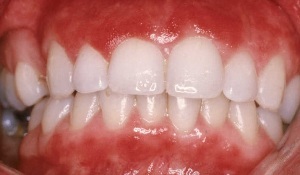
On the photo gingivitis
By nature this disease has an inflammatory character. It arises because of the accumulation and rapid multiplication of a large number of pathogens on the teeth and gums.
Without timely and proper treatment, the disease can worsen and lead to more serious complications.
How to use an antiseptic in this case? Rinsing the mouth with a solution of chlorhexidine bigluconate allows you to cope with gingivitis even in the early stages.

The solution is used for rinsing with stomatitis and some other inflammatory diseases of the oral cavity( periodontitis, glossitis).
In addition, the procedure can be recommended by the dentist after the removal or treatment of the tooth.
How to use a solution for prevention?
Chlorhexidine is an excellent tool for preventing plaque and stone formation.
Due to its antibacterial properties, it protects well from these unpleasant phenomena. It is used for the treatment of removable dentures.
Instruction for use of the preparation
 For maximum effect, rinse the mouth with an antiseptic solution immediately after the teeth have been cleaned.
For maximum effect, rinse the mouth with an antiseptic solution immediately after the teeth have been cleaned.
By analogy with brushing teeth, mouth rinsing should be done 2 times a day. To do this, 10 ml of 0.05% aqueous solution should be taken into the mouth and rinsed for about 30 seconds.
After this, it is not recommended to eat or drink liquid for 15-20 minutes. This will lead to the flushing of chlorhexidine bigluconate from the teeth and gums.
Mechanism of action
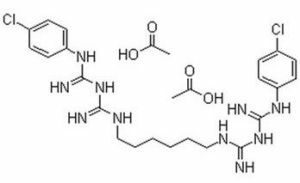 The agent has an effective ability to modify the properties of the membrane cells of bacteria and microorganisms.
The agent has an effective ability to modify the properties of the membrane cells of bacteria and microorganisms.
When used in most bacteria, the cytoplasmic membrane is destroyed. They lose osmotic balance, which leads to inevitable death.
When treated with a solution of the oral cavity, it has only a local effect, not absorbed into the tissue and not entering the blood. After rinsing, part of the remedy remains on the mucous membranes of the mouth until 24 hours. During this period, they have an antiseptic effect.
Advantages and disadvantages of
The wide application of the drug, including in dentistry, is caused by the following moments:
-
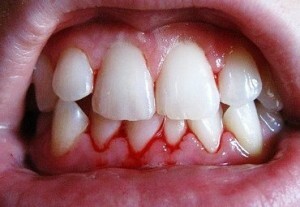 it is very effective in fighting most microorganisms;
it is very effective in fighting most microorganisms; - preserves antiseptic properties even when interacting with blood and purulent masses;
- can be used in low concentration, which avoids irritation of the oral mucosa( especially important in dentistry);
- prolonged action of the drug after application;
-
 is harmless, there have been no cases of overdose in practice;
is harmless, there have been no cases of overdose in practice; - low cost.
From the shortcomings of the drug can be called:
- unpleasant taste with a touch of bitterness;
- low efficiency in fighting viruses;
- side effects.
Contraindications and side effects of
It is contraindicated to use people with high sensitivity to the main active ingredient - chlorhexidine bigluconate.
Rarer, but possible side effects include:
-
 a change in taste perception, the emergence of a sustained aftertaste of bitterness;
a change in taste perception, the emergence of a sustained aftertaste of bitterness; - burning in the field of application;
- numbness and dryness in the oral cavity, possible painful sensations;
- increased gingival hemorrhage;
- increased sensitivity of the gums.
Feedback on the use of chlorhexidine for mouth rinse with aphthous stomatitis:
Form and storage conditions
The preparation should be stored in the package in which it is manufactured. Transfusion into another container is not desirable. The product should be protected from direct sunlight and overheating above 25 ° C.
Keep out of the reach of children. It is suitable for 3 years from the date of manufacture.
Ointment Sibirocort with chlorhexidine
Chlorhexidine 1% is part of the Sibiocort Ointment. In addition, the drug contains hydrocortisone( 1%) and excipients.
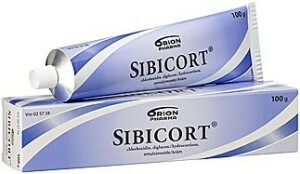 Ointment is intended to alleviate and treat such diseases and skin lesions as eczema in acute or chronic form, dermatitis( skin inflammation), neurodermatitis, concomitant infections of bacterial origin.
Ointment is intended to alleviate and treat such diseases and skin lesions as eczema in acute or chronic form, dermatitis( skin inflammation), neurodermatitis, concomitant infections of bacterial origin.
Only external application of Sibicort for elimination of dermatological problems is allowed. The drug is not used in dentistry. Treatment of the oral cavity is unacceptable.
The high efficiency of the product has been proven for years and does not cause controversy. It is widely used both in dentistry and other fields of medicine. He deservedly takes a leading position among other antiseptic drugs not only in Russia, but all over the world.
